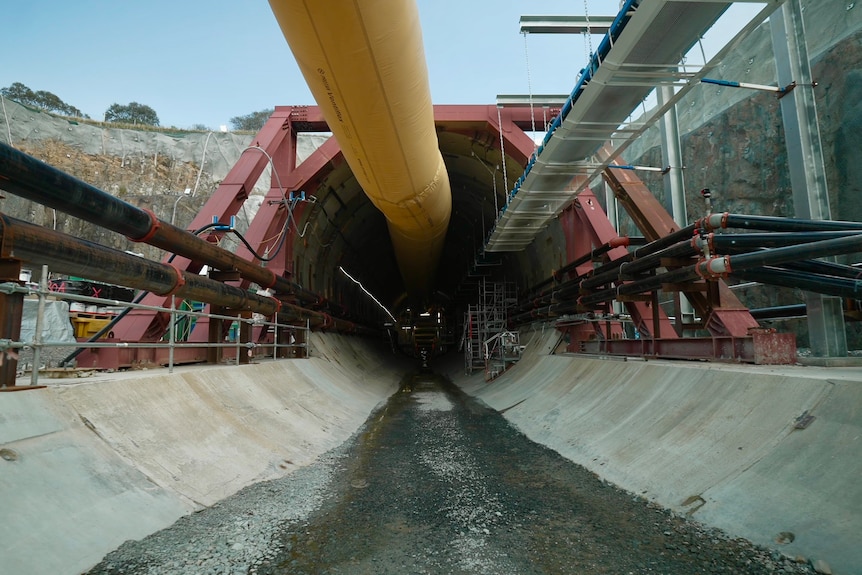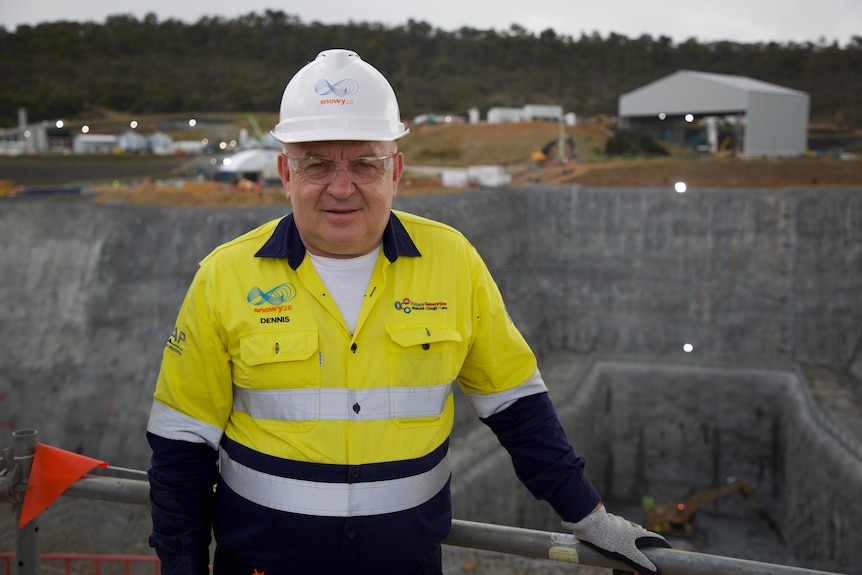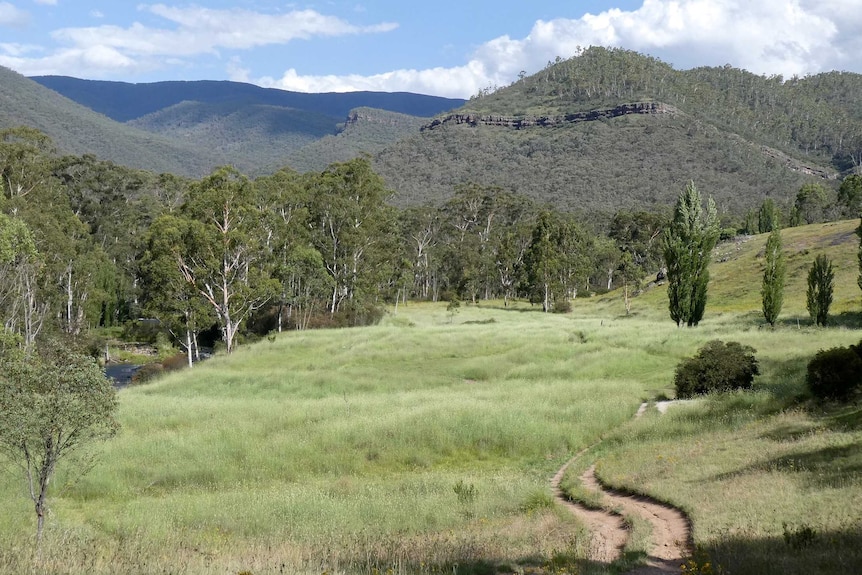Florence’s Work Routine in Snowy 2.0 Project Progress
Deep within the majestic Kosciuszko National Park, a tunnel boring machine is steadily carving its way through the tough rock formations. After being stuck in soft ground for nearly a year, the machine, known as Florence, has resumed its journey. This progress comes as a significant relief to Snowy Hydro, as Florence plays a crucial role in excavating the longest tunnel within the ambitious Snowy 2.0 hydropower project.
Despite this milestone, challenges persist. Florence is currently cutting through 2 meters of rock at a time. Subsequently, a series of nine concrete segments are carefully placed to reinforce the tunnel. Following this, a complex system comprising the borer, conveyor belt, electricity supply, ventilation pipes, and various other equipment is meticulously advanced to repeat the cycle.

Florence’s Work Routine and Snowy Progress
Entrance to the tunnel drilled by Florence is shown in the image provided by Snowy Hydro. Rock extracted by Florence is then brought to the surface, as depicted in another image supplied by Snowy Hydro. Following Florence’s drilling, workers promptly apply cement panels to the newly exposed rock.
Since its restoration, Florence has been consistently advancing, allowing for the installation of three rings per day. Remarkably, on one occasion this week, Florence achieved the installation of six rings in a single day.
With 7,500 rings remaining to be installed, there is anticipation of potential geological challenges in the future.
Although Florence is back in operation, the pace of progress is not as swift as desired.
Challenges with Time and Budget
The Snowy 2.0 initiative entails an intricate system of subterranean passages connecting Tantangara Dam at a higher elevation in the Snowy Mountains to Talbingo Reservoir situated at a lower altitude.
Water will be transferred from Tantangara to Talbingo through a substantial underground power facility, generating 2,200 megawatts of electricity that can be activated as needed to bolster the fluctuating outputs of other sustainable energy sources in the electricity network. During periods of low electricity rates, water will be pumped back in the opposite direction to effectively “recharge” this massive water-based energy storage system.

The construction of the tunnel, stretching from Tantangara to the Talbingo intake 26km away, has been ongoing for approximately 5 years. Various challenges have plagued the project, notably in December 2022 when Florence, the machine, got stuck in soft ground, causing a sinkhole and bringing work to a standstill. Snowy Hydro had to renegotiate terms with Future Generation due to cost overruns and delays, abandoning the original fixed-price contract. Both parties are now sharing the expenses, with the project’s total cost estimated at $12 billion. The sinkhole incident above Florence during routine work has significantly impacted Snowy’s progress.
Challenges in Florence’s Work Routine and Snowy Progress
However, to adhere to the revised deadline of achieving its initial power output by late 2027, adjustments must be made to address Florence’s slow pace.
The acquisition of three tunnel boring machines was essential to facilitate the excavation of the tunnels required for Snowy 2.0.
Named after Australia’s pioneering female electrical engineer, Florence Violet McKenzie, Florence was entrusted with the task of drilling the 16-kilometre segment connecting Tantangara Dam to the subterranean power station, referred to as the headrace.
This particular stretch poses the greatest length and geological challenges within the entire project.
With only 440 meters of the headrace tunnel completed thus far, and the impending obstacle of the Long Plain fault line yet to be overcome, Snowy Hydro and Future Generation are exploring strategies to simultaneously advance work at both ends of the headrace.

Progress of Florence Work Routine at Snowy Hydro Project
In the ongoing development at Snowy Hydro, a section of the tunnel has been successfully completed by one of the two other boring machines. This tunnel now serves a dual purpose as a transport and ventilation passage, connecting to the power generation cavern site.
Snowy Hydro CEO Dennis Barnes expressed the need to maintain an average daily progress of 12m, a target they are currently falling short of but anticipate achieving in the coming months.
Despite efforts to speed up the work routine, known as Florence, it is unlikely to meet the project’s deadlines. Barnes mentioned that a decision will soon be made regarding the necessity of acquiring a fourth tunnel boring machine or resorting to the “drill and blast” technique at the opposite end.
The Florence control room remains a hub of activity as workers prepare to blast a wall, marking significant progress in the Snowy Hydro project.
In Demand: Financial Engineers
Addressing the challenges linked to Florence’s work routine is crucial for advancing the Snowy 2.0 project.
According to Mr. Barnes, the stagnation of Florence’s progress served as a pivotal point highlighting the obstacles faced by the project.
Previously, the primary risk burden under a fixed-price contract rested on the joint venture partner.

Snowy Hydro’s CEO, Dennis Barnes, highlighted the challenges faced by the project, leading to potential losses for the contractor. The implementation of an “incentivised target cost” approach now ensures that both Snowy Hydro and Future Generation share the risks associated with cost overruns. Mr. Barnes humorously acknowledged that while Snowy Hydro bears most of the risk, the change in contract terms has breathed new life into the Snowy 2.0 project. The most significant transformation has been the shift in culture towards genuine collaboration rather than constant commercial negotiations. Additionally, insiders point out the crucial role of Mr. Barnes, who assumed his position in February 2023, in steering the project in the right direction. Former CEO Paul Broad played a pivotal role in initiating the project; however, his confrontational style was deemed unsuitable for managing the complexities of a joint venture project. The Florence work routine and Snowy progress have significantly improved under the new leadership.
Sinkholes and the Financial Burden of Snowy 2.0 Project
The costs associated with Snowy 2.0 project are substantial in various aspects.
Initially projected at $2 billion during its announcement by former Prime Minister Malcolm Turnbull, the project’s current cost overseen by the Albanese government has escalated to six times that amount. The Commonwealth government, being the sole shareholder of Snowy Hydro, has pledged additional financial backing, although the exact figure remains undetermined.
The significant progress of construction activities within Kosciuszko National Park, coupled with the anticipated energy market demand for the scheme’s 2,200 megawatts to be operational within this decade, are key factors that render walking away from Snowy 2.0 project nearly impossible.
Florence work routine, Snowy progress.

Progress Update on the Snowy Hydro Project
Florence work routine and Snowy progress have been closely monitored and evaluated by Dennis Barnes, who finds the project to be as viable as ever from economic, environmental, and systemic perspectives.
“The project boasts a 7.4% return and a net present value of $3 billion against a total cost of $12 billion,” stated Barnes confidently.
One of the key advantages highlighted by Barnes is the proactive approach towards risk management. He mentioned, “We are now anticipating and preparing for potential risks rather than merely reacting to them.”
With completion progress standing at 51-52%, Barnes emphasized the correlation between project advancement and increased confidence in its success, stating, “The more work we accomplish, the more assured we become.”
For more information on the Snowy Hydro Project, please visit our site 60time.com. Don’t forget to follow us on social media at Facebook.



